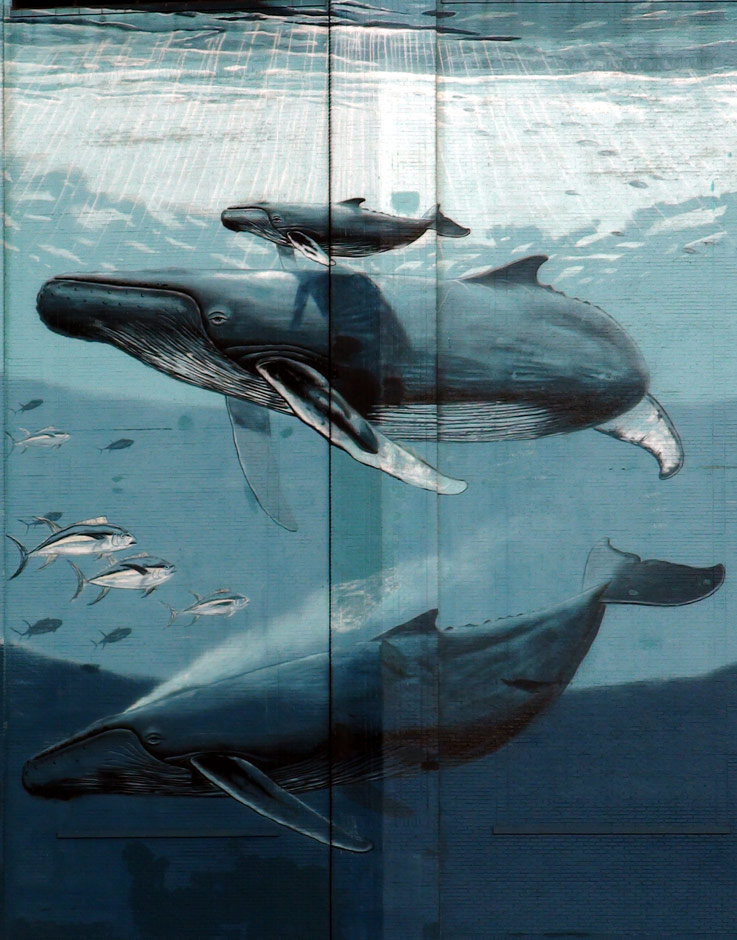Artist Wyland Hopes to Save Whaling Wall Mural From Demolition

Photo by David Saddler, used under a Creative Commons License
Last year, Property reported on a massive renovation of the Marketplace Design Center. The plan, which is scheduled to begin in June of this year, would turn Design Center into a mixed-use building involving large apartments, hotel rooms, studio space and a reconfigured showcase for interior designers.
Part of the design will include a reconstruction of the western facade of the building, which would spell the end of the artist Wyland’s “East Coast Humpbacks,” painted in six days in Philadelphia in 1993.
“I have to digest it a little bit,” Wyland said on the phone from his west coast studio. He had not yet heard his mural was slated for demolition. “I try to save as many of my murals as I can because it’s not just public art — it’s art that has a message of conservation.”
Wyland painted his Philadelphia mural while on a whirlwind tour in 1993. Over 17 weeks, he painted 17 murals from Portland, Maine, to Key West, Florida — including the Philadelphia mural, dedicated by Ed Rendell on July 19th.
Wyland painted 100 “Whaling Walls” between 1981 and 2008. His first one was painted in in Laguna Beach, California; the final one was done in Beijing, China. Not all of them remain.
“You cannot save them all,” Wyland said. “It’s harder to save them then paint them. There’s a lot of politics, and you really don’t know: Sometimes these developers they just do what they want to do without regard for the public art.”
Wyland says the destruction of his mural is a violation of the Visual Artist Rights Act, a federal law passed in 1990 that protects artists’ moral rights. The law is intended “to prevent any destruction of a work of recognized stature, and any intentional or grossly negligent destruction of that work is a violation of that right.” Wyland says he never signed a waiver permitting the destruction of his Philadelphia whaling mural, though VARA allows building owners some relief for removal. Per a National Endowment for the Arts guide to the law written in 1997:
If the building owner wants to remove an artwork which can be safely removed, the artist’s rights apply unless (1) the building owner has made a diligent, good faith but unsuccessful attempt at notification of the artist of his removal intent, or (2) the building owner did provide notice, but the artist either failed to remove the work or to pay for its removal within 90 days after receiving notice. A “diligent, good-faith attempt” involves sending notice by registered mail to the artist at his most recent address as recorded by the Register of Copyrights.
Wyland’s mural could still be saved if the artist can prove it’s of a “recognized stature.” But although VARA has been a law since 1990, many suits under it have been settled — meaning there isn’t much case law on the issue.
Murals in Philadelphia come and go. Philadelphia’s whaling wall was not commissioned by the Mural Arts Program, which requires artists to waive their VARA rights. Mural Arts COO Joan Reilly said they do that because it’s tough to get building owners to agree to a mural otherwise. “When we started this, we thought these murals would be up in perpetuity, but as it’s advanced we’ve learned it’s more of a rotating gallery.” That’s due to the ever-changing development of a city like Philadelphia. Of the 3,600 murals MAP has done, only about 1,800 are active. When a Mural Arts mural is removed in Philadelphia, the program generally attempts to replace it with a new one somewhere nearby. After David Guinn’s “Autumn” mural at 9th and Bainbridge was removed due to a new townhouse, the artist painted “Autumn Revisited” on the side of the Fleisher Art Memorial.
VARA was in the news recently when artists cited VARA in a lawsuit attempting to prevent the destruction of New York City graffiti mecca 5 Pointz. A judge ruled in favor of the building’s owner and the buildings were whitewashed.
But one suit, filed by Ken Twitchell in 2006, was successful. His six-story mural of Ed Ruscha in downtown Los Angeles was painted over in 2006; he later settled for $1.1 million. Another VARA suit came last year, when the founder of the Los Angeles Fine Arts Squad sued over the removal of “Brooks Avenue Painting.” The mural had been the location of a famous photograph of The Doors.
“You couldn’t paint in six weeks the murals I’m painting in six days,” Wyland told the Inquirer in 1993, before painting the Philadelphia mural. “Look at my forearms. Holding the spray gun is like holding a quart of paint straight out for 14 hours. Feel the calluses on my thumb. Some days I limp out to the mural, but then someone says, ‘It’s so beautiful. I can’t believe what you’ve done for us.’ And it gives me energy.”
If Philadelphia’s whaling wall does disappear, don’t fret: There are still two more nearby, painted in the weeks after the one in Philly. “Humpbacks off the Jersey Coast” is on the side of the Boardwalk Mall in Wildwood, New Jersey, while “Delaware Marine Mammals” is in Wilmington, Delaware.
Wyland hopes the one in Philadelphia can be saved. “If they were smart, [the developers] would see value in the mural,” he said. “First of all, it’s a federal offense, no matter how they want to frame it. And I think once you put this story out in the community that this mural may disappear, you’re going to find a lot of support for it.”